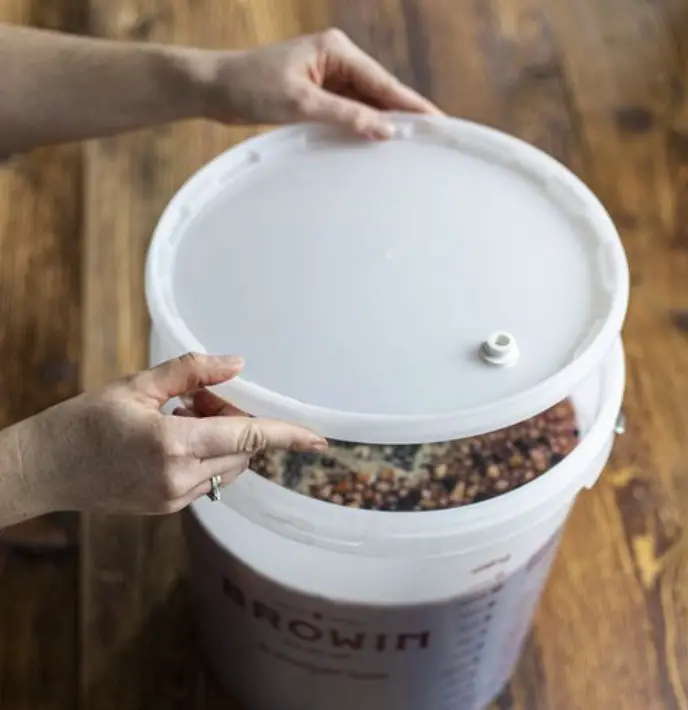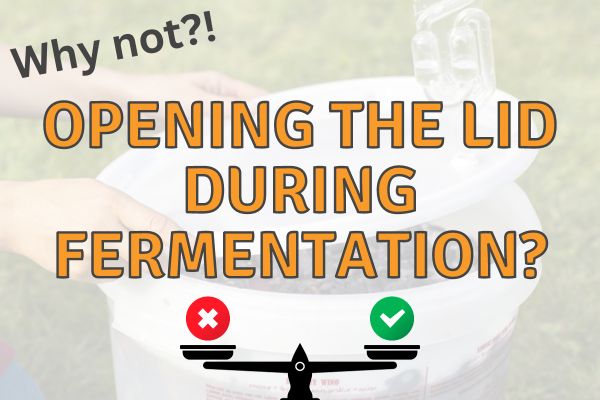As an experienced brewer, one question I get asked a lot is, “Can you open the lid during fermentation?”.
The short answer to this is: No, you shouldn’t open the lid during fermentation if you can avoid it.
The further the fermentation has progressed, the worse the effects of opening the lid. In general, it is better to open the lid early on during active fermentation, but can be detrimental to expose you brew to too much oxygen later on.
This answer, however, prompts another question: Why is oxygen bad for fermentation?
Well, mainly because it stops fermentation and encourages the growth of spoilage organisms.
In this post, I’ll dive deep into the reasons behind this, based on my personal experiences and factual information.
The Impact of Opening the Lid During Fermentation
When you open the lid of your fermenter, you’re exposing your beer to oxygen.
This is especially harmful because the fermentation process creates a blanket of carbon dioxide that protects the beer from oxygen.

Opening the lid disrupts this protective blanket, allowing oxygen to come into contact with the beer and potentially cause the problems we’ve discussed.
Reasons to not let oxygen get in contact with your brew is:
- Mold and Spoilage Bacteria Thrive in Oxygen-Rich Environments: A primary reason for avoiding oxygen exposure during fermentation is the risk of contamination. Mold, as well as many spoilage bacteria, thrive in environments where oxygen is readily available. When you open the lid or otherwise expose your brew to the outside environment, you’re essentially inviting these unwanted guests in. Once they establish themselves, they can quickly ruin the flavor and safety of your beverage.
- Brewing Yeast’s Competitive Advantage: The brewing yeast, used to ferment your brew, has a unique characteristic that sets it apart from many other microorganisms: it can function well in both aerobic (with oxygen) and anaerobic (without oxygen) conditions. However, its growth advantage is most prominent under anaerobic conditions. In an environment devoid of oxygen, brewing yeast can outcompete most other microbes, ensuring that the fermentation process proceeds as intended. Introducing oxygen disrupts this balance, giving potential spoilage organisms an edge.
- Oxidative Off-Flavors and Staling: Oxygen can react with various compounds in beer, leading to oxidative off-flavors. This is often described as a cardboard-like, stale, or sherry-like taste in the finished product. Even small amounts of oxygen exposure during fermentation or later stages can lead to these unwanted flavors. And the longer the exposure, the more pronounced these flavors become.
- Reduction in Beer Stability: Oxygen can also adversely affect the stability of beer, both in terms of flavor and clarity. Oxidation reactions can lead to haze formation, making the beer look cloudy. While some types of beer, like certain wheat beers, are expected to be hazy, this is not the case for most varieties. Thus, unintended haziness can be seen as a flaw, especially for styles that are expected to be clear.
- Compromising the Yeast’s Health: In an anaerobic environment, yeast will produce alcohol as a by-product. When oxygen is reintroduced, yeast might shift their metabolic processes, potentially stressing them and leading to the production of unwanted by-products that can negatively impact the flavor of the brew.
In conclusion, while it might be tempting to sneak a peek during fermentation, it’s best to resist the urge.
Of course, the shorter exposure the better, and the more rigourous the fermentation when the lid is closed again, the faster the protective CO2 blanket is replenished.
Understanding Fermentation
Before we delve into why oxygen is bad for fermentation, it’s important to understand what fermentation actually is.
Fermentation is the process through which yeast consumes sugar and produces alcohol and carbon dioxide.
The catch is, that this process is fairly inefficient and therefore mostly takes place in the absence of oxygen.

This is the basic mechanism that turns your wort (the sweet mixture of water, malt, and hops) or sugary fruit juice into beer, cider or wine!
The key players in this process are the yeast and the sugar—and, interestingly enough, oxygen can interfere with this relationship.
Why Oxygen is Bad for Fermentation
Oxygen exposure during the anaerobic phase of fermentation can cause a number of problems.
The Three main reasons are:
First, oxygen can react with the alcohol to produce acetaldehyde, a compound that gives beer a green apple flavor that is generally considered undesirable.
Second, oxygen exposure can lead to oxidization, which can give your beer off-flavors that taste like cardboard or sherry.
Third, oxygen can slow down or even halt fermentation by causing yeast to switch back to aerobic respiration, a less efficient process that doesn’t produce alcohol.
Keeping that lid tightly closed ensures an environment where brewing yeast can work its magic undisturbed, and where unwanted reactions, contaminants, and flavors can’t take hold.
Your patience will be rewarded with a brew that’s true to its intended flavor, aroma, and appearance. So remember, no matter how curious you are about the progress, think twice before opening that lid!
Oxygen and Yeast in Fermentation
east, as a living organism, requires a certain environment to thrive and do its job.
In the early stages of fermentation, known as the aerobic phase, yeast uses oxygen to multiply and build strength for the anaerobic phase—the actual fermentation process.
However, once the fermentation shifts to its anaerobic phase, the presence of oxygen can have detrimental effects on the process and the end products.
Reasons to Avoid Oxygen in the Anaerobic Phase of Fermentation:
- Oxidation of Compounds: Oxygen can cause the oxidation of various compounds produced during fermentation. This can lead to off-flavors and undesirable changes in the color of the final product. For example, in brewing beer, the introduction of oxygen post-fermentation can result in stale flavors, often referred to as “oxidative staling.”
- Inhibition of Alcohol Production: In the anaerobic phase, yeast cells switch their metabolism to produce ethanol (alcohol) from sugars. The presence of oxygen can disrupt this process, potentially reducing the yield of alcohol.
- Potential for Contamination: Oxygen can support the growth of unwanted aerobic bacteria and spoilage organisms. These organisms can produce off-flavors and might even lead to spoilage of the fermented product.
- Reduction in Shelf-life: Oxidative reactions promoted by the presence of oxygen can lead to the deterioration of the final product over time, reducing its shelf life.
- Alteration in Nutrient Profile: Some vitamins and other nutrients can be sensitive to oxygen, leading to their degradation. An excess of oxygen can, therefore, reduce the nutritional value of certain fermented foods.
- Economic Implications: The oxidation reactions and potential for spoilage mean that products might need to be discarded or sold at reduced prices, leading to economic losses for producers.
In conclusion, while oxygen is essential for yeast propagation in the aerobic phase of fermentation, it becomes detrimental once the anaerobic phase starts. Hence, it’s vital to ensure that oxygen is excluded during this phase to produce high-quality fermented products.
How to Avoid Oxygen Exposure During Fermentation
There are several ways to avoid oxygen exposure during fermentation. First, avoid opening the lid of your fermenter until fermentation is complete and you really need to.
If you feel you really need to check on your beer, use a transparent fermenter or just use the airlock to observe the activity of fermentation process without opening the lid.
Second, when racking your brew, transfer your it carefully to avoid splashing, which can introduce oxygen. Use a siphon instead of pouring the beer.
Third, if you need to add ingredients after fermentation has begun, sanitize them thoroughly to avoid introducing oxygen.
The Importance of Good Practices in Brewing
Brewing is a mixture of science and art, and like any craft, it requires good practices to achieve the best results. Avoiding oxygen exposure during fermentation is one of these good practices.
By understanding the role of oxygen in fermentation and taking steps to minimize its impact, you can improve the quality of your beer and avoid common off-flavors.
Conclusion
In conclusion, oxygen plays a dual role in the brewing process. It is crucial in the early stages of fermentation to help yeast multiply and build strength. However, once the actual fermentation process begins, oxygen becomes harmful and can cause off-flavors or even halt fermentation.
To summarize, here are the key facts about oxygen and fermentation:
1. Fermentation is the process through which yeast consumes sugar and produces alcohol and carbon dioxide.
2. Oxygen is beneficial in the early stages of fermentation, when yeast is multiplying.
3. Oxygen becomes harmful once the actual fermentation process begins.
4. Oxygen can react with alcohol to produce acetaldehyde, which gives beer a green apple flavor.
5. Oxygen can cause oxidization, which gives beer off-flavors like cardboard or sherry.
6. Oxygen can interrupt fermentation by causing yeast to switch back to aerobic respiration.
7. Opening the lid of your fermenter exposes your beer to oxygen.
8. To avoid oxygen exposure, don’t open the lid until fermentation is complete.
9. Transfer beer carefully and use a siphon to avoid introducing oxygen.
10. Sanitize any ingredients added after fermentation begins to avoid introducing oxygen.
In my personal experience, understanding the role of oxygen in fermentation and how to manage it has been crucial in improving the quality of my beers. So, next time you’re tempted to peek inside your fermenter during fermentation, remember: patience is a virtue—and in this case, it can make all the difference in your brew!
FAQs
Does oxygen need to be present for fermentation to occur?
No, fermentation can occur without the presence of oxygen.
Does fermentation take oxygen?
No, fermentation does not require oxygen.
Why is oxygen bad for fermentation?
Oxygen is not ideal for fermentation because it can hinder the growth of the desired microorganisms and promote the growth of unwanted bacteria or molds.
Why is air not allowed in fermentation?
Air is not allowed in fermentation because it can introduce unwanted microorganisms or bacteria into the process. These microorganisms can interfere with the desired fermentation process and lead to spoilage or off-flavors in the final product. By excluding air, fermentation can occur in a controlled environment, allowing the desired microorganisms to thrive and produce the desired end product.
Why is oxygen bad for brewing?
Oxygen is detrimental to brewing because it can negatively impact the flavor, aroma, and shelf life of beer.
Why oxygen is not allowed in fermentation?
Oxygen is not allowed in fermentation because it inhibits the growth of the microorganisms responsible for the fermentation process.




